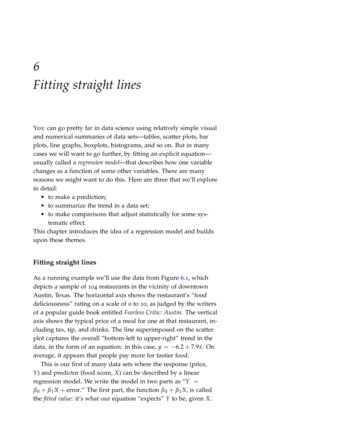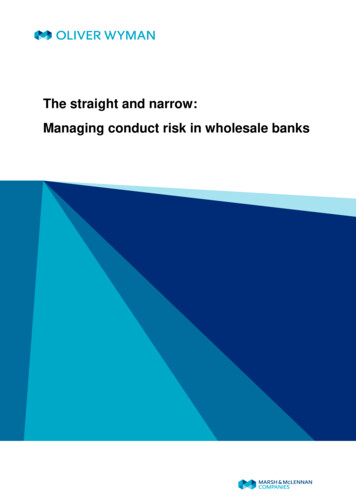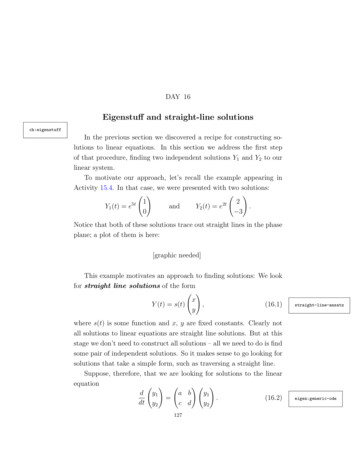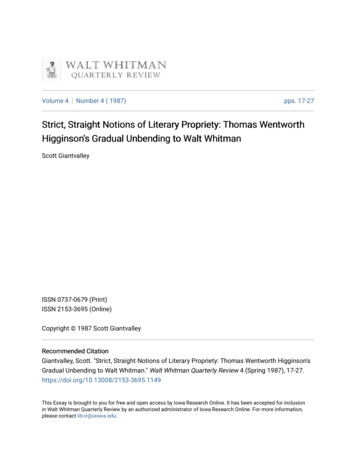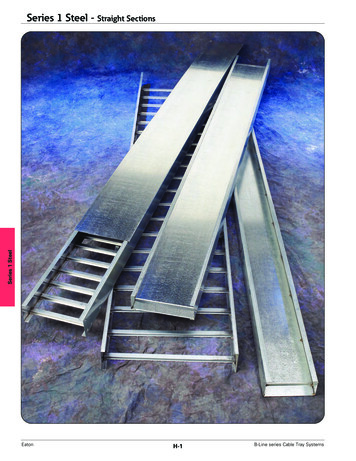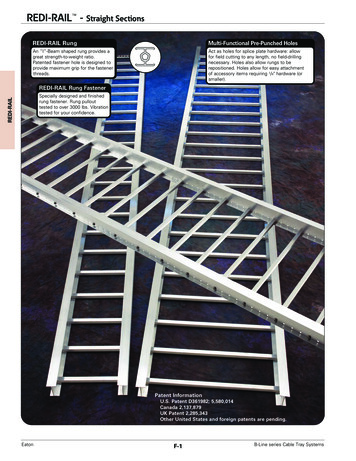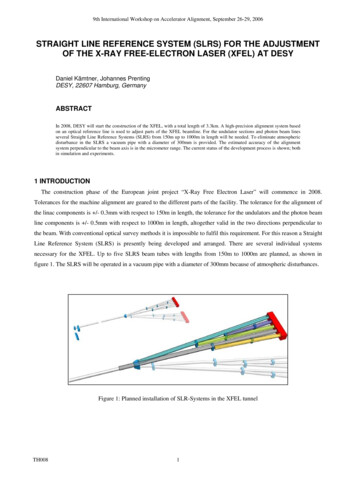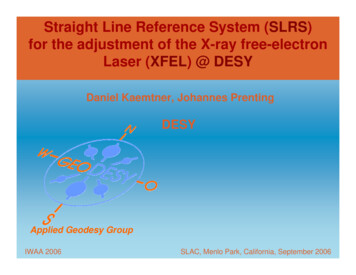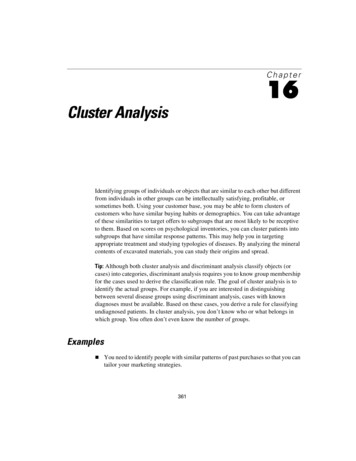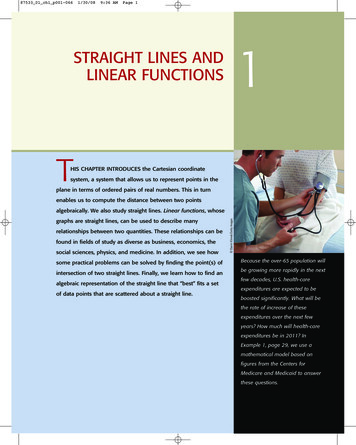
Transcription
87533 01 ch1 p001-0661/30/089:36 AMPage 11STRAIGHT LINES ANDLINEAR FUNCTIONSTHIS CHAPTER INTRODUCES the Cartesian coordinatesystem, a system that allows us to represent points in theplane in terms of ordered pairs of real numbers. This in turnenables us to compute the distance between two pointsgraphs are straight lines, can be used to describe manyrelationships between two quantities. These relationships can befound in fields of study as diverse as business, economics, thesocial sciences, physics, and medicine. In addition, we see howsome practical problems can be solved by finding the point(s) ofintersection of two straight lines. Finally, we learn how to find analgebraic representation of the straight line that “best” fits a setof data points that are scattered about a straight line. Darrin Klimek/Getty Imagesalgebraically. We also study straight lines. Linear functions, whoseBecause the over-65 population willbe growing more rapidly in the nextfew decades, U.S. health-careexpenditures are expected to beboosted significantly. What will bethe rate of increase of theseexpenditures over the next fewyears? How much will health-careexpenditures be in 2011? InExample 1, page 29, we use amathematical model based onfigures from the Centers forMedicare and Medicaid to answerthese questions.
87533 01 ch1 p001-06621/30/089:36 AMPage 21 STRAIGHT LINES AND LINEAR FUNCTIONS1.1 The Cartesian Coordinate SystemThe Cartesian Coordinate SystemThe real number system is made up of the set of real numbers together with the usualoperations of addition, subtraction, multiplication, and division. We assume that youare familiar with the rules governing these algebraic operations (see Appendix B).Real numbers may be represented geometrically by points on a line. This line iscalled the real number, or coordinate, line. We can construct the real number line asfollows: Arbitrarily select a point on a straight line to represent the number 0. Thispoint is called the origin. If the line is horizontal, then choose a point at a convenientdistance to the right of the origin to represent the number 1. This determines the scalefor the number line. Each positive real number x lies x units to the right of 0, and eachnegative real number x lies x units to the left of 0.In this manner, a one-to-one correspondence is set up between the set of real numbers and the set of points on the number line, with all the positive numbers lying to theright of the origin and all the negative numbers lying to the left of the origin (Figure 1).Origin–4FIGURE 1yO–2– 2The real number liney-axis–3Originx-axisx–10112234x3In a similar manner, we can represent points in a plane (a two-dimensional space)by using the Cartesian coordinate system, which we construct as follows: Take twoperpendicular lines, one of which is normally chosen to be horizontal. These linesintersect at a point O, called the origin (Figure 2). The horizontal line is called thex-axis, and the vertical line is called the y-axis. A number scale is set up along thex-axis, with the positive numbers lying to the right of the origin and the negative numbers lying to the left of it. Similarly, a number scale is set up along the y-axis, with thepositive numbers lying above the origin and the negative numbers lying below it.FIGURE 2The Cartesian coordinate systemyP(x, y)yOxxFIGURE 3An ordered pair in the coordinate planeNote The number scales on the two axes need not be the same. Indeed, in manyapplications different quantities are represented by x and y. For example, x may represent the number of cell phones sold and y the total revenue resulting from the sales.In such cases it is often desirable to choose different number scales to represent thedifferent quantities. Note, however, that the zeros of both number scales coincide atthe origin of the two-dimensional coordinate system.We can represent a point in the plane uniquely in this coordinate system by anordered pair of numbers—that is, a pair (x, y), where x is the first number and y thesecond. To see this, let P be any point in the plane (Figure 3). Draw perpendicularsfrom P to the x-axis and y-axis, respectively. Then the number x is precisely the number that corresponds to the point on the x-axis at which the perpendicular through Phits the x-axis. Similarly, y is the number that corresponds to the point on the y-axis atwhich the perpendicular through P crosses the y-axis.Conversely, given an ordered pair (x, y) with x as the first number and y the second, a point P in the plane is uniquely determined as follows: Locate the point on thex-axis represented by the number x and draw a line through that point perpendicularto the x-axis. Next, locate the point on the y-axis represented by the number y and drawa line through that point perpendicular to the y-axis. The point of intersection of thesetwo lines is the point P (Figure 3).
87533 01 ch1 p001-0661/30/089:36 AMPage 331.1 THE CARTESIAN COORDINATE SYSTEMIn the ordered pair (x, y), x is called the abscissa, or x-coordinate, y is called theordinate, or y-coordinate, and x and y together are referred to as the coordinates ofthe point P. The point P with x-coordinate equal to a and y-coordinate equal to b isoften written P(a, b).The points A(2, 3), B( 2, 3), C( 2, 3), D(2, 3), E(3, 2), F(4, 0), andG(0, 5) are plotted in Figure 4.NoteIn general, (x, y) (y, x). This is illustrated by the points A and E in Figure 4.y4B(–2, 3)A(2, 3)E(3, 2)2F(4, 0)–3–113x5–2C(–2, –3)D(2, – 3)–4G(0, – 5)FIGURE 4Several points in the coordinate plane–6The axes divide the plane into four quadrants. Quadrant I consists of the points P withcoordinates x and y, denoted by P(x, y), satisfying x 0 and y 0; Quadrant II, thepoints P(x, y) where x 0 and y 0; Quadrant III, the points P(x, y) where x 0 andy 0; and Quadrant IV, the points P(x, y) where x 0 and y 0 (Figure 5).yQuadrant II(–, )Quadrant I( , )xOFIGURE 5Quadrant III(–, –)Quadrant IV( , –)The four quadrants in the coordinateplaneThe Distance FormulaOne immediate benefit that arises from using the Cartesian coordinate system is thatthe distance between any two points in the plane may be expressed solely in terms ofthe coordinates of the points. Suppose, for example, (x1, y1) and (x2, y2) are any twopoints in the plane (Figure 6). Then we have the following:Distance FormulaThe distance d between two points P1(x1, y1) and P2(x2, y2) in the plane isgiven byd 21x2 x1 2 2 1 y2 y1 2 2For a proof of this result, see Exercise 46, page 8.(1)
87533 01 ch1 p001-06641/30/089:36 AMPage 41 STRAIGHT LINES AND LINEAR FUNCTIONSExplore & DiscussRefer to Example 1. Supposewe label the point (2, 6) asP1 and the point ( 4, 3) asP2. (1) Show that the distance d between the twopoints is the same as thatobtained earlier. (2) Provethat, in general, the distanced in Formula (1) is independent of the way we label thetwo points.In what follows, we give several applications of the distance formula.EXAMPLE 1 Find the distance between the points ( 4, 3) and (2, 6).SolutionLet P1( 4, 3) and P2(2, 6) be points in the plane. Then we havex1 4 andx2 2y1 3y2 6Using Formula (1), we haved 2 32 1 42 4 2 16 32 2 262 32 145 315APPLIED EXAMPLE 2 The Cost of Laying Cable In Figure 7, S represents the position of a power relay station located on a straight coastalhighway, and M shows the location of a marine biology experimental station on anearby island. A cable is to be laid connecting the relay station at S with the experimental station at M via the point Q that lies on the x-axis between O and S. If thecost of running the cable on land is 3 per running foot and the cost of running thecable underwater is 5 per running foot, find the total cost for laying the cable.y (feet)M(0, 3000)FIGURE 7The cable will connect the relay station Sto the experimental station M.x (feet)OQ(2000, 0)S(10,000, 0)Solution The length of cable required on land is given by the distance from Sto Q. This distance is (10,000 2000), or 8000 feet. Next, we see that the lengthof cable required underwater is given by the distance from Q to M. This distance is210 2000 2 2 13000 02 2 220002 30002 113,000,000 3605.55or approximately 3605.55 feet. Therefore, the total cost for laying the cable is3(8000) 5(3605.55) 42,027.75or approximately 42,027.75.EXAMPLE 3 Let P(x, y) denote a point lying on a circle with radius r and centerC(h, k) (Figure 8). Find a relationship between x and y.Solution By the definition of a circle, the distance between C(h, k) and P(x, y)is r. Using Formula (1), we have21x h2 2 1 y k2 2 r
87533 01 ch1 p001-0661/30/089:36 AMPage 551.1 THE CARTESIAN COORDINATE SYSTEMywhich, upon squaring both sides, gives the equation(x h)2 ( y k)2 r 2P(x, y)which must be satisfied by the variables x and y.rA summary of the result obtained in Example 3 follows.C(h, k)xFIGURE 8Equation of a CircleAn equation of the circle with center C(h, k) and radius r is given by(x h)2 ( y k)2 r 2A circle with radius r and center C(h, k)(2)EXAMPLE 4 Find an equation of the circle with (a) radius 2 and center ( 1, 3)and (b) radius 3 and center located at the origin.Solutiona. We use Formula (2) with r 2, h 1, and k 3, obtaining3x 1 1 2 4 2 1 y 32 2 221x 12 2 1 y 32 2 4(Figure 9a).b. Using Formula (2) with r 3 and h k 0, we obtainx 2 y 2 32x 2 y2 9(Figure 9b).yy2(–1, 3)3x1x–1FIGURE 9(a) The circle with radius 2 andcenter ( 1, 3)(b) The circle with radius 3 andcenter (0, 0)Explore & Discuss1. Use the distance formula to help you describe the set of points in the xy-plane satisfyingeach of the following inequalities, where r 0.a. (x h)2 ( y k)2 r 2c. (x h)2 ( y k)2 r 2222b. (x h) ( y k) rd. (x h)2 ( y k)2 r 22. Consider the equation x 2 y 2 4.a. Show that y 24 x 2.b. Describe the set of points (x, y) in the xy-plane satisfying the equation(i) y 24 x 2(ii) y 24 x 2
87533 01 ch1 p001-06661/30/089:36 AMPage 61 STRAIGHT LINES AND LINEAR FUNCTIONS1.1 Self-Check Exercises1. a. Plot the points A(4, 2), B(2, 3), and C( 3, 1).b. Find the distance between the points A and B, betweenB and C, and between A and C.c. Use the Pythagorean theorem to show that the trianglewith vertices A, B, and C is a right triangle.2. The accompanying figure shows the location of cities A, B,and C. Suppose a pilot wishes to fly from city A to city Cbut must make a mandatory stopover in city B. If the single-engine light plane has a range of 650 mi, can the pilot makethe trip without refueling in city B?y (miles)C(600, 320)300200100B(200, 50)A(0, 0)x (miles)100200300400500600700Solutions to Self-Check Exercises 1.1 can be found on page 9.1.1 Concept Questions1. What can you say about the signs of a and b if the pointP(a, b) lies in: (a) The second quadrant? (b) The thirdquadrant? (c) The fourth quadrant?2. a. What is the distance between P1(x1, y1) and P2(x2, y2)?b. When you use the distance formula, does it matterwhich point is labeled P1 and which point is labeledP2? Explain.1.1 ExercisesIn Exercises 1–6, refer to the accompanying figure anddetermine the coordinates of the point and the quadrantin which it is located.In Exercises 7–12, refer to the accompanying figure.yBy42CD3–6AAD–4x2–24–2 FB6GE1–4x–5–3–1135797. Which point has coordinates (4, 2)?–3–5E–7CF8. What are the coordinates of point B?9. Which points have negative y-coordinates?10. Which point has a negative x-coordinate and a negativey-coordinate?1. A2. B3. C11. Which point has an x-coordinate that is equal to zero?4. D5. E6. F12. Which point has a y-coordinate that is equal to zero?
87533 01 ch1 p001-0661/30/089:36 AMPage 71.1 THE CARTESIAN COORDINATE SYSTEMIn Exercises 13–20, sketch a set of coordinate axes andthen plot the point.13. ( 2, 5)14. (1, 3)15. (3, 1)16. (3, 4)17. (8, 27)18. ( 25, 32)19. (4.5, 4.5)20. (1.2, 3.4)In Exercises 21–24, find the distance between the points.21. (1, 3) and (4, 7)22. (1, 0) and (4, 4)23. ( 1, 3) and (4, 9)24. ( 2, 1) and (10, 6)736. DELIVERY CHARGES A furniture store offers free setup anddelivery services to all points within a 25-mi radius of itswarehouse distribution center. If you live 20 mi east and14 mi south of the warehouse, will you incur a deliverycharge? Justify your answer.37. OPTIMIZING TRAVEL TIME Towns A, B, C, and D arelocated as shown in the accompanying figure. Two highways link town A to town D. Route 1 runs from town A totown D via town B, and Route 2 runs from town A to townD via town C. If a salesman wishes to drive from town Ato town D and traffic conditions are such that he couldexpect to average the same speed on either route, whichhighway should he take in order to arrive in the shortesttime?y (miles)25. Find the coordinates of the points that are 10 units awayfrom the origin and have a y-coordinate equal to 6.C(800, 1500)D(1300, 1500)26. Find the coordinates of the points that are 5 units awayfrom the origin and have an x-coordinate equal to 3.100027. Show that the points (3, 4), ( 3, 7), ( 6, 1), and (0, 2)form the vertices of a square.2128. Show that the triangle with vertices ( 5, 2), ( 2, 5), and(5, 2) is a right triangle.B (400, 300)30. Radius 3 and center ( 2, 4)31. Radius 5 and center at the origin32. Center at the origin and passes through (2, 3)33. Center (2, 3) and passes through (5, 2)34. Center ( a, a) and radius 2a35. DISTANCE TRAVELED A grand tour of four cities begins at cityA and makes successive stops at cities B, C, and D beforereturning to city A. If the cities are located as shown in theaccompanying figure, find the total distance covered on thetour.y (miles)C (– 800, 800)500B (400, 300)D (– 800, 0)A(0, 0)x (miles)500100038. MINIMIZING SHIPPING COSTS Refer to the figure for Exercise 37. Suppose a fleet of 100 automobiles are to beshipped from an assembly plant in town A to town D.They may be shipped either by freight train along Route 1at a cost of 44 /mile/
system, a system that allows us to represent points in the plane in terms of ordered pairs of real numbers. This in turn enables us to compute the distance between two points algebraically. We also study straight lines. Linear functions, whose graphs are straight lines, can be used to describe many relationships between two quantities. These relationships can be found in fields of study as .
